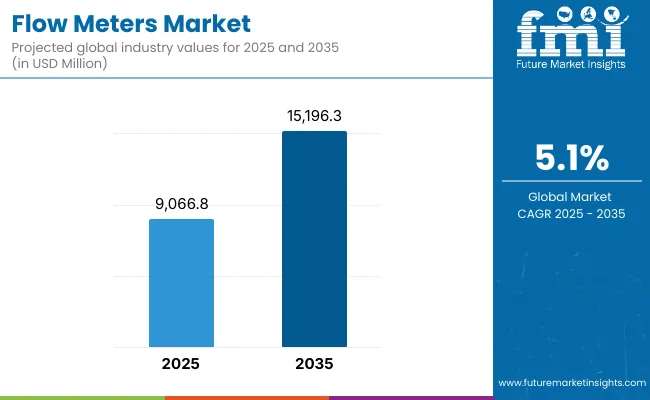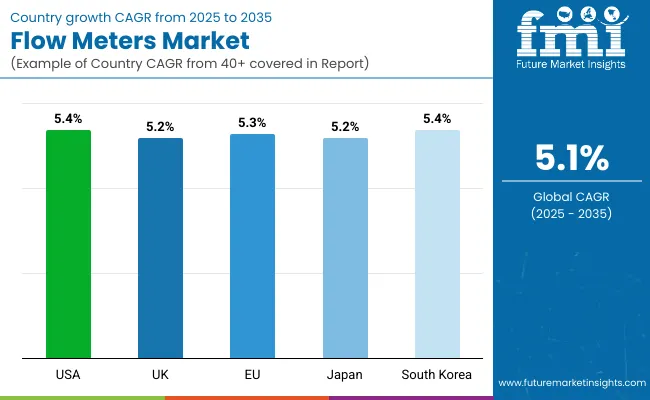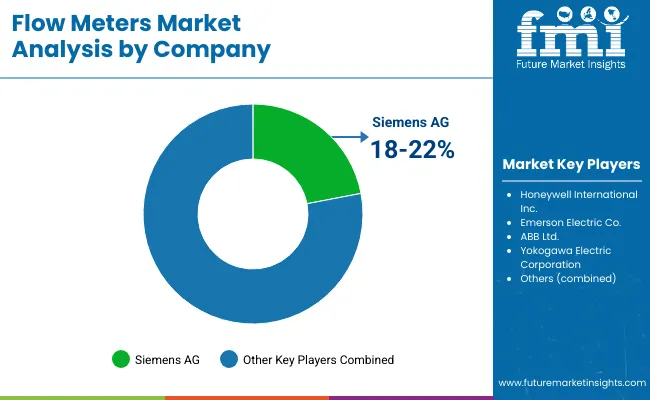The global flow meters market is set to experience steady growth as industries increasingly rely on accurate measurement and monitoring of liquid, gas, and steam flows to ensure process efficiency, reduce waste, and meet regulatory requirements. Flow meters are essential in a wide range of sectors, including oil and gas, water and wastewater, chemical processing, power generation, and food and beverage production.
The adoption of advanced technologies, such as ultrasonic and Coriolis flow meters, along with the integration of digital and IoT-enabled monitoring systems, is driving demand for high-precision flow measurement solutions. As industries place greater emphasis on operational efficiency, automation, and sustainability, the flow meters market is expected to expand consistently through 2035.
In 2025, the global flow meters market is estimated at approximately USD 9,066.8 Million. By 2035, it is projected to grow to around USD 15,196.3 Million, reflecting a compound annual growth rate (CAGR) of 5.1%. This growth reflects increasing demand for precise flow measurement, regulatory compliance, and process optimization across various industries.

North America continues to be a key market for flow meters, supported by mature oil and gas operations, new investments in infrastructure modernization in countries like the USA and Canada, and rigorous regulatory requirements for accurate measurement and reporting. Smart flow meters come designed with digital communication ability and are still being developed, a trend reflected in the investments made in the USA and Canada.
In particular, Europe with its stringent environmental regulations, high focus on renewable energy sources, and the requirement for water and wastewater management is another important market. High-precision flow meters have been adopted relatively early in chemical processing and power generation in countries like Germany, the United Kingdom, and France. The focus on sustainability and resource optimization in the region is also another factor aiding market growth.
The Asia-Pacific region is becoming the fastest-growing market for flow meters due to the rapid industrialization, urbanization, and expanding energy and water infrastructure. Advanced flow measurement solutions are being adopted most widely in the region by China, India, and Japan, whose industries increasingly seek to improve process efficiency, and regulatory compliance.
The demand for flow meters in the region is amplified due to the growth of manufacturing, chemical processing, and municipal water treatment facilities in the region which is anticipated to witness strong growth in the flow meter market over the next 10 years.
Challenges
High Initial Costs, Calibration Complexity, and Regulatory Compliance
The flow meters market is facing challenges because the deployment of advanced flow measurement technologies entails high initial costs, particularly for types such as ultrasonic, Coriolis, and magnetic flow meters. These require precise engineering and high-end sensors, and the installation is generally done by a specialized company, making them expensive for small-scale industries.
Almost all types of flow meters need regular maintenance and recalibration that makes them very convoluted to use at different kinds of fluid with different temperatures and pressure condition, which is another major challenge of flow meters in adoption.
Moreover, stringent regulatory compliance with ISO, API, and regional safety standards operates as major roadblocks onsite, particularly in sectors like oil & gas, water management, and chemical processing where accurate flow measurement is crucial for getting regulatory approvals.
Opportunities
Growth in Smart Flow Monitoring, IoT-Enabled Meters, and Sustainability Initiatives
Despite these challenges the flow meters market continues to offer significant growth potential thanks to the increasing demand for smart, real-time flow monitoring solutions, devices integrated with IoT, and sustainable fluid management practices.
Artificially powered flow sensors, cloud-based analytics, and remote monitoring systems are revolutionizing oil and gas, and this trend has been extended to industrial fluid measurement. Moreover, increasing demand for the installation of flow meters as part of smart water grids, renewable energy applications, and precision agriculture have been a result of the need for water conservation, energy efficiency, and emission reduction. Wireless communication, predictive maintenance, and blockchain-enabled data security is driving even more transformation in the market.
| Market Shift | 2020 to 2024 Trends |
|---|---|
| Regulatory Landscape | Compliance with ISO, EPA, and industry-specific accuracy standards. |
| Consumer Trends | Demand for real-time monitoring, automated flow control, and precision metering. |
| Industry Adoption | High usage in oil & gas, water treatment, HVAC systems, and industrial automation. |
| Supply Chain and Sourcing | Dependence on metal-based sensors, ultrasonic transducers, and high-precision digital processors. |
| Market Competition | Dominated by industrial automation firms, instrumentation manufacturers, and metering system integrators. |
| Market Growth Drivers | Growth fueled by industrial process optimization, water management initiatives, and automation trends. |
| Sustainability and Environmental Impact | Moderate adoption of water-saving smart meters and low-energy consumption sensors. |
| Integration of Smart Technologies | Early adoption of IoT-enabled smart meters, remote monitoring systems, and automated industrial flow control. |
| Advancements in Sensor Technology | Development of high-accuracy ultrasonic and Coriolis-based flow sensors. |
| Market Shift | 2025 to 2035 Projections |
|---|---|
| Regulatory Landscape | Stricter energy efficiency mandates, carbon-neutral flow measurement policies, and AI-driven regulatory compliance. |
| Consumer Trends | Growth in AI-powered predictive maintenance, smart flow meters, and cloud-connected industrial flow analytics. |
| Industry Adoption | Expansion into hydrogen fuel systems, AI-optimized irrigation, and smart city water networks. |
| Supply Chain and Sourcing | Shift toward nanotechnology-based flow sensors, AI-enhanced fluid monitoring, and sustainable material sourcing. |
| Market Competition | Entry of IoT-driven flow analytics startups, AI-powered sensor technology firms, and cloud-based monitoring providers. |
| Market Growth Drivers | Accelerated by AI-based flow analytics, blockchain-secured metering data, and smart manufacturing process integration. |
| Sustainability and Environmental Impact | Large-scale shift toward zero-emission fluid monitoring, real-time water conservation analytics, and carbon-neutral metering solutions. |
| Integration of Smart Technologies | Expansion into AI-driven flow optimization, digital twin metering systems, and real-time environmental impact tracking. |
| Advancements in Sensor Technology | Evolution toward self-learning flow meters, nanotechnology-based sensors, and next-gen multi-parameter flow measurement solutions. |

The Flow Meters market in the USA is witnessing steady growth, driven by increasing demand for precision flow measurement in industries such as oil & gas, water treatment, and chemical processing. The adoption of advanced digital and ultrasonic flow meters for real-time monitoring and efficiency optimization is fueling market expansion. Additionally, stringent regulatory requirements for accurate fluid measurement in industrial applications are further supporting demand.
| Country | CAGR (2025 to 2035) |
|---|---|
| USA | 5.4% |
The flow meters market is growing in the United Kingdom as there is an increasing demand for accurate fluid measurement in water management, pharmaceuticals, energy, and other sectors. The growth of the market is influenced by the trends in smart metering technology and IoT-based flow meters. More regulatory mandates encouraging the effective utilization of water and fuel will also be driving market demand.
| Country | CAGR (2025 to 2035) |
|---|---|
| UK | 5.2% |
Across the European Union, the flow meters market is advancing at a steady pace as the industries are focusing on process automation and energy efficiency. Market growth is driven by increasing usage of Coriolis, ultrasonic, and electromagnetic flow meters in water treatment and industrial automation. Finally, stringent emissions control and water conservation regulations from the EU are also driving the demand for high-precision flow measurement solutions.
| Region | CAGR (2025 to 2035) |
|---|---|
| European Union (EU) | 5.3% |
Moderate growth is observed in Japan's flow meters market propelled by technological developments in precision instrumentation and the growing penetration of the smart metering solutions. The country has a stronghold in semiconductor, automotive and water management industries that is driving the demand for high-accuracy flow measurement devices. Explore the market expansion despite trends in miniaturized and AI-driven flow metering systems.
| Country | CAGR (2025 to 2035) |
|---|---|
| Japan | 5.2% |
In South Korea, the flow meters market is growing owing to increasing investment in industrial automation and smart water management systems. Market demand is being driven by the increase in the use of ultrasonic and electromagnetic flow meters in the oil & gas and manufacturing sectors. No margin availability of potential data can lead to financial issues due to high costs and subsequent disasters.
| Country | CAGR (2025 to 2035) |
|---|---|
| South Korea | 5.4% |
Key manufacturers are developing high-precision, sturdy and real-time observing setups with the integration of digitalization, automation, and IoT-based smart metering technologies. The Segmental Analysis of the market is carried out on the basis of Type:(Differential Pressure, Positive Displacement, Ultrasonic, Turbine, Magnetic, Coriolis, Vortex, Others) & End-Use Industry:(Water & Wastewater, Refining & Petrochemical, Oil & Gas, Chemical, Power Generation, Pulp & Paper, Food & Beverage, Pharmaceutical, Metals & Mining, Others).
Ultrasonic flow meters segment has the highest market share as ultraflow meters offer non-invasive, high accuracy flow measurement solutions across various industries. Ultrasonic flow meters operate by sending high frequency sound waves through fluids, making them perfect for measuring flow of water, natural gas, crude oil, and chemicals with no interference with the pipeline.
Ultrasonic flow meters are increasingly integrated with real-time data monitoring systems, wireless communication modules, and cloud-based analytics to allow remote flow measurement and predictive maintenance as the adoption of Internet-of-Things (IoT)-enabled smart metering solutions continues to rise. The growing demand for non-invasive, low-power, and long-lasting flow measuring devices has been an additional factor fueling demand for ultrasonic technology.
Potentiometer segment is still in high demand, especially in water & wastewater, chemical processing, food & beverage applications. The magnetic flow meter works using electromagnetic fields to measure the speed of conducting fluids, which work great in sludge, industrial liquid flow, high-corrosion environments.
The demand for durable magnetic flow meters with high accuracies is on the rise due to increased investment in smart water infrastructure, automated fluid management systems, and chemical process control. With the growing need for operational flexibility and minimizing maintenance costs, manufacturers are emphasizing on multi-parameter, battery-operated, and wireless flow measurement solutions.
Due to the need for high precision in flow measurement solutions for leakage detection, consumption measurement, and compliance purposes, the Water & Wastewater segment accounts for the largest share of Flow Meters Market, as municipalities, utilities and industrial water treatment plants rely on such solutions. Overall, flow meters are essential instruments in any water distribution network and are used to help minimize water losses and provide optimal system performance.
Amid rising global concern surrounding water conservation, dilapidating infrastructure and sustainable resource management, both governmental and private organizations are betting on smart metering solutions, automated water distribution systems and AI-driven flow monitoring platforms. The increasing use of ultrasonic and magnetic flow meters in municipal water supply, industrial wastewater treatment, and desalination facilities is also accelerating market growth.
The Oil & Gas segment is also experiencing a substantial rise, since flow meters are pivotal for measuring crude oil, natural gas, and refined petroleum products at points throughout the production, transportation, and distribution processes. Flow meters assist in monitoring pipeline efficiency, detecting flow anomalies, and optimizing fuel delivery networks.
Moreover, stringent safety regulations, surging energy efficiency initiatives coupled with technological advancements in multi-phase flow metering technology is propelling the demand for high precision Coriolis, ultrasonic and turbine flow meters across upstream, midstream and downstream oil & gas sectors.
Demand for fluid measurement and control applications across several end-user industries, including industrial, water, oil & gas, chemical and pharmaceutical has surged and consequently, the demand for new and innovative flow meters reflects this trend.
Leading players are emphasizing on solutions like AI-based flow rate analytics, smart flow meter integration and IoT based real-time monitoring systems that improve accuracy of measurement, drive operational efficiency as well as predictive maintenance.
Market participants consist of instrumentation manufacturers, industrial automation companies, and smart metering solution providers who all have a special role to play in the flow measurement advancement, AI-based data analysis, and sustainable resource management.
Market Share Analysis by Key Players & Flow Meter Manufacturers
| Company Name | Estimated Market Share (%) |
|---|---|
| Siemens AG | 18-22% |
| Honeywell International Inc. | 12-16% |
| Emerson Electric Co. | 10-14% |
| ABB Ltd. | 8-12% |
| Yokogawa Electric Corporation | 5-9% |
| Other Flow Meter Manufacturers (combined) | 30-40% |
| Company Name | Key Offerings/Activities |
|---|---|
| Siemens AG | Develops AI-powered electromagnetic and ultrasonic flow meters, IoT-enabled industrial flow monitoring, and predictive maintenance solutions. |
| Honeywell International Inc. | Specializes in smart gas and liquid flow meters, AI-enhanced flow rate optimization, and industrial automation metering solutions. |
| Emerson Electric Co. | Provides ultrasonic and Coriolis flow meters, AI-assisted energy efficiency tracking, and digital flow control systems. |
| ABB Ltd. | Focuses on high-precision vortex and thermal mass flow meters, AI-powered process automation, and real-time flow monitoring solutions. |
| Yokogawa Electric Corporation | Offers IoT-integrated industrial flow meters, AI-powered flow sensor calibration, and predictive analytics for fluid measurement. |
Key Market Insights

Siemens AG (18-22%)
Siemens leads the flow meters market, offering AI-driven electromagnetic flow monitoring, IoT-based real-time data tracking, and digital twin flow analysis solutions.
Honeywell International Inc. (12-16%)
Honeywell specializes in smart gas and liquid flow meters, ensuring AI-powered industrial metering, process automation integration, and remote monitoring capabilities.
Emerson Electric Co. (10-14%)
Emerson provides high-precision ultrasonic and Coriolis flow meters, optimizing AI-assisted energy efficiency tracking and advanced fluid measurement technologies.
ABB Ltd. (8-12%)
ABB focuses on vortex and thermal mass flow meters, integrating AI-driven process automation, digital monitoring, and industrial metering enhancements.
Yokogawa Electric Corporation (5-9%)
Yokogawa develops real-time industrial flow monitoring solutions, ensuring AI-powered sensor calibration, predictive analytics, and smart fluid management innovations.
Other Key Players (30-40% Combined)
Several industrial measurement companies, automation solution providers, and smart water management firms contribute to next-generation flow metering innovations, AI-powered fluid monitoring, and IoT-enabled industrial applications. These include:
The overall market size for the flow meters market was USD 9,066.8 Million in 2025.
The flow meters market is expected to reach USD 15,196.3 Million in 2035.
Growth is driven by the rising demand for precision measurement in industries, increasing adoption of smart flow meters, and expanding applications in water management, oil & gas, and chemical sectors.
The top 5 countries driving the development of the flow meters market are the USA, Germany, China, Japan, and India.
Ultrasonic and Magnetic Flow Meters are expected to command a significant share over the assessment period.






Full Research Suite comprises of:
Market outlook & trends analysis
Interviews & case studies
Strategic recommendations
Vendor profiles & capabilities analysis
5-year forecasts
8 regions and 60+ country-level data splits
Market segment data splits
12 months of continuous data updates
DELIVERED AS:
PDF EXCEL ONLINE
Ultrasonic Flowmeters Market Trends – Growth & Forecast 2025 to 2035
Flower Box Market Size and Share Forecast Outlook 2025 to 2035
Flow Pack Films Market Size and Share Forecast Outlook 2025 to 2035
Flow Pack Machine Market Size and Share Forecast Outlook 2025 to 2035
Flow Indicator Market Size and Share Forecast Outlook 2025 to 2035
Flow Chemistry Market Size and Share Forecast Outlook 2025 to 2035
Flow Wrappers Market Size and Share Forecast Outlook 2025 to 2035
Flow Computer Market Size and Share Forecast Outlook 2025 to 2035
Flow Meter Devices Market Size, Share, and Forecast 2025 to 2035
Flow Cytometry Market - Trends & Growth Forecast 2025 to 2035
Flow Wrap Machines Market by Horizontal & Vertical Systems Through 2025 to 2035
Flow Wrap Packaging Market Growth from 2025 to 2035
Flower Extract Market Analysis by Type, Application and Form Through 2035
Flow Wrap Machines Market Analysis – Size, Share & Industry Trends 2025-2035
Flow Diverter Market Analysis – Size, Trends & Forecast 2024-2034
Flow Wrap Market from 2024 to 2034
Flowback Tank Market Growth – Trends & Forecast 2024-2034
Flowpack Paper Packaging Market
Flow Cytometer Market
Inflow Pressure Screen Market Analysis - Size, Share, and Forecast Outlook 2025 to 2035

Thank you!
You will receive an email from our Business Development Manager. Please be sure to check your SPAM/JUNK folder too.
Chat With
MaRIA